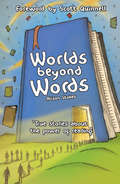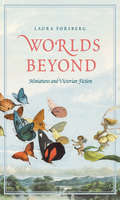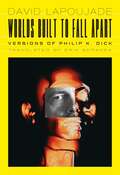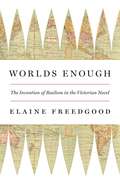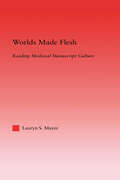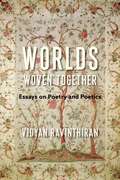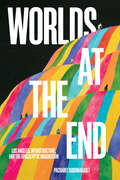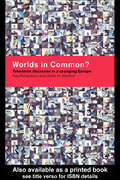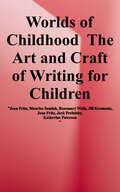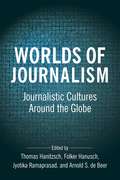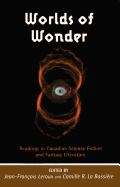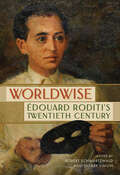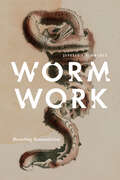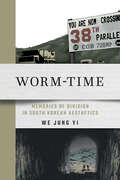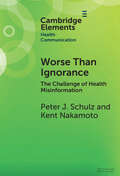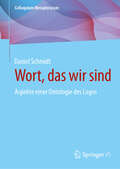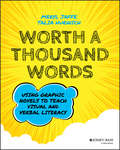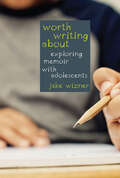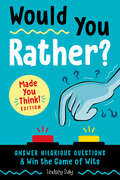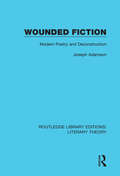- Table View
- List View
Worlds Beyond Words: True Stories About the Power of Literacy (Quick Reads Ser.)
by Alison StokesA collection of real-life stories from people who have improved their lives through better literacy. Foreword by Scott QuinnellSome people take the power of words for granted. But for the thousands of people who struggle with poor literacy, words can be scary things. The men and women featured in this book have overcome their fears to improve their reading later in life. Whether they are famous businessmen or sports stars, teenagers in care, middle-aged mums, young soldiers or refugees forced to flee bloodshed in their own home countries, they all share a common desire to learn.Their stories will inspire others to follow journeys of their own.Alison Stokes is a writer and journalist, who writes for national magazines in the UK and US and regional newspapers in Wales. For many years she was a features editor at Trinity Mirror’s South Wales Echo. She also works as a part-time university lecturer in journalism and publishing manager.
Worlds Beyond Words: True Stories About the Power of Literacy (Quick Reads)
by Alison StokesA collection of real-life stories from people who have improved their lives through better literacy. Foreword by Scott QuinnellSome people take the power of words for granted. But for the thousands of people who struggle with poor literacy, words can be scary things. The men and women featured in this book have overcome their fears to improve their reading later in life. Whether they are famous businessmen or sports stars, teenagers in care, middle-aged mums, young soldiers or refugees forced to flee bloodshed in their own home countries, they all share a common desire to learn.Their stories will inspire others to follow journeys of their own.Alison Stokes is a writer and journalist, who writes for national magazines in the UK and US and regional newspapers in Wales. For many years she was a features editor at Trinity Mirror’s South Wales Echo. She also works as a part-time university lecturer in journalism and publishing manager.
Worlds Beyond: Miniatures and Victorian Fiction
by Laura ForsbergAn innovative study of how the Victorians used books, portraits, fairies, microscopes, and dollhouses to imagine miniature worlds beyond perception In 1856, Elizabeth Gaskell discovered a trove of handmade miniature books that were created by Charlotte and Branwell Brontë in their youth and that, as Gaskell later recalled, &“contained an immense amount of manuscript, in an inconceivably small space.&” Far from being singular wonders, these two-inch volumes were part of a wide array of miniature marvels that filled the drawers and pockets of middle- and upper-class Victorians. Victorian miniatures pushed the boundaries of scientific knowledge, mechanical production, and human perception. To touch a miniature was to imagine what lay beyond these boundaries. In Worlds Beyond, Laura Forsberg reads major works of fiction by George Eliot, Jane Austen, Charles Dickens, and Lewis Carroll alongside minor genres like the doll narrative, fairy science tract, and thumb Bible. Forsberg guides readers through microscopic science, art history, children&’s culture, and book production to show how Victorian miniatures offered scripts for expansive fantasies of worlds beyond perception.
Worlds Built to Fall Apart: Versions of Philip K. Dick (Univocal)
by David LapoujadePhilosophically analyzing the work of one of the twentieth century&’s most popular, and peculiar, science fiction authors Despite his enduring popularity, Philip K. Dick (1928–1982)—whose short stories and novels were adapted into or influenced many major films and television shows, including Blade Runner, Total Recall, The Truman Show, and The Man in the High Castle—has long been a marginal figure in American literature, even in the science fiction genre he helped revolutionize. Here, an influential French philosopher offers a major new perspective on an author who was known as much for his eccentricities and excesses as for his writing. For David Lapoujade, it is precisely the many ways in which Dick&’s works seem to hover on the brink of losing all touch with reality that make him such a singular figure, both as a sci-fi author and as a thinker of contemporary life. In Worlds Built to Fall Apart, Lapoujade defines sci-fi as a way of thinking through the creation of worlds and argues that Dick does so by creating worlds that fall rapidly to pieces. Whatever his mechanism to bring this about (drugs or madness, alien satellite transmissions or encroaching parallel universes), the effect is always to reveal reality to be a construction, in which certain people determine what appears as real to the rest of us. Orienting Dick within philosophy and drawing connections to a wide variety of other thinkers and artists, this remarkable reading shows how he proposes unstable, fluctuating futures in which tinkering with reality has become the best means of resisting total control. Engaging with most of Philip K. Dick&’s published works, as well as with several of his essays and his notorious psychic autobiography The Exegesis, Lapoujade hones in on the &“war of the psyches&” that underlies Dick&’s critique of reality. He puts Dick&’s work in conversation with a vast array of subjects—from cybernetics to schizoanalysis, and from Pop art to David Lynch, J. G. Ballard, and William S. Burroughs—revealing Dick&’s oeuvre to comprise a profound reality defined by artifice, precarity, and control. Retail e-book files for this title are screen-reader friendly.
Worlds Enough: The Invention of Realism in the Victorian Novel
by Elaine FreedgoodA short, provocative book that challenges basic assumptions about Victorian fictionNow praised for its realism and formal coherence, the Victorian novel was not always great, or even good, in the eyes of its critics. As Elaine Freedgood reveals in Worlds Enough, it was only in the late 1970s that literary critics constructed a prestigious version of British realism, erasing more than a century of controversy about the value of Victorian fiction.Examining criticism of Victorian novels since the 1850s, Freedgood demonstrates that while they were praised for their ability to bring certain social truths to fictional life, these novels were also criticized for their formal failures and compared unfavorably to their French and German counterparts. She analyzes the characteristics of realism—denotation, omniscience, paratext, reference, and ontology—and the politics inherent in them, arguing that if critics displaced the nineteenth-century realist novel as the standard by which others are judged, literary history might be richer. It would allow peripheral literatures and the neglected wisdom of their critics to come fully into view. She concludes by questioning the aesthetic racism built into prevailing ideas about the centrality of realism in the novel, and how those ideas have affected debates about world literature.By re-examining the critical reception of the Victorian novel, Worlds Enough suggests how we can rethink our practices and perceptions about books we think we know.
Worlds Made Flesh: Chronicle Histories and Medieval Manuscript Culture (Studies in Medieval History and Culture)
by Lauryn MayerThis book focuses on the use of the past in two senses. First, it looks at the way in which medieval texts from the eighth to the fifteenth centuries discussed the past: how they presented history, what kinds of historical narratives they employed, and what anxieties gathered around the practice of historiography. Second, this study examines twentieth-century interactions with this textual past, and the problems that have arisen for critics trying to negotiate this radically different textual culture. Lauryn Mayer examines chronicle histories that have been largely ignored by scholars, bringing these neglected texts into dialogue with contemporaneous canonical works such as Troilus and Criseyde, The House of Fame, the Morte Darthur, Beowulf, and The Battle of Maldon.
Worlds Within
by Vilashini CooppanCooppan (literature, U. of California-Santa Cruz) looks at the interplay between nationalism and psychoanalysis, scoffing at critics who say both may already be extinct. He explores both the psychic inside and the global outside in a series of national narratives that span the globe and the 20th century. They are inner territories, Conrad's Heart of Darkness and the postcolonial novel; W. E. B. Du Bois and the psychic politics of place; race, nation, and genre in Frantz Fanon; new nations and new novels; and Severo Sarduy's fantasmatic Cuba. Annotation c2010 Book News, Inc. , Portland, OR (booknews. com)
Worlds Woven Together: Essays on Poetry and Poetics (Literature Now)
by Vidyan RavinthiranWriting about poetry follows models provided either by academic scholarship or literary journalism, each with its pitfalls. The former distances the reader from the poem and effaces the critic’s personality. In literary journalism, the critic is front and center, but the discussion is introductory and prioritizes value judgments. In either case, entrenched practices and patterns of privilege limit one’s perspective. The situation worsens when it comes to minoritized poets and poets from the Global South, where the focus is on restrictive notions of identity: the stylistic innovations of literary works get ousted by prefabricated historical narratives.In Worlds Woven Together, the critic, poet, and scholar Vidyan Ravinthiran searches for alternatives, pursuing close, imaginative readings of a variety of writers. His essays are open-ended, attentive, and curious, unabashedly passionate and subjective yet keenly analytical and investigative. Discussing neglected authors and those well-known in the West, Ravinthiran sees politics as inseparable from literary form and is fascinated by the relation of the creative consciousness to the violences of history. The book features essays on writers including Mir Taqi Mir, Ana Blandiana, A. K. Ramanujan, Marianne Moore, Eunice de Souza, Czeslaw Milosz, Ted Hughes, Rae Armantrout, Arvind Krishna Mehrotra, Galway Kinnell, Dawn Lundy Martin, and Vahni Capildeo. Revealing serendipitous connections—between poems and cultures, between lines of verse and the lives we lead—Worlds Woven Together is for all readers fascinated by the mechanics and politics of poetry.
Worlds at the End: Los Angeles, Infrastructure, and the Apocalyptic Imagination (Critical Race, Indigeneity, and Relationality)
by Pacharee SudhinarasetWorlds at the End attends to a body of literature that renders Los Angeles’s infrastructure, or its material foundations, as central to the rise and consolidation of colonial life. Pacharee Sudhinaraset employs a women-of-color feminist methodology to examine Indigenous, Black, Asian American, and Latinx literary works about apocalypse and the end times. Worlds at the End analyzes destruction, rupture, and continuance through texts ranging from Karen Tei Yamashita’s Tropic of Orange, which considers racial colonial infrastructure, to the work of Diné poet Esther Belin, which illuminates how the separation between the Indian reservation and LA is part of a broader infrastructural network of termination. And she unpacks Octavia Butler’s post-apocalyptic novel, Parable of the Sower, where LA’s freeways and roadways are routes of forced migration, colonization, and flight. Tearing down existing institutions that marginalize people of color and moving past them, Worlds at the End highlights the imaginaries of those subjugated, racialized, and made other, for whom modernity, freedom, and progress meant violence, brutality, and relegation to the status of devalued surplus populations. As Sudhinaraset deftly shows, the apocalypse marks moments of historical and spatial transition, offering stories of doomsdays that will give rise to resurgence and regeneration.
Worlds in Common?: Television Discourses in a Changing Europe
by Kay Richardson Ulrike H. MeinhofWorlds in Common? examines the newly emerging forms of language used in satellite television programmes, exploring a wide range of genres including twenty-four hour news broadcasting, culture channels, talk shows, local TV and European news. Focusing on the experiences of British and German viewers, the authors discuss these new forms of communication brought about by the technological and economic upheavals in Europe in the late 1990s. This interaction between media theories and media discourses, makes the book highly relevant for researchers in media and cultural studies as well as linguistics, and provides an important and innovatory link between these different approaches.
Worlds of Childhood: The Art and Craft of Writing for Children
by Katherine Paterson Maurice Sendak Rosemary Wells Jill Krementz Jean Fritz Jack PrelutskySix prominent children's authors, including Maurice Sendak, Rosemary Wells, and Jack Prelutsky, agree that to enter the worlds that children inhabit, you must possess the magic word: honesty.
Worlds of Journalism: Journalistic Cultures Around the Globe (Reuters Institute Global Journalism Series)
by Folker Hanusch Thomas Hanitzsch Jyotika Ramaprasad Arnold S. de BeerHow do journalists around the world view their roles and responsibilities in society? Based on a landmark study that has collected data from more than 27,500 journalists in 67 countries, Worlds of Journalism offers a groundbreaking analysis of the different ways journalists perceive their duties, their relationship to society and government, and the nature and meaning of their work.Challenging assumptions of a universal definition or concept of journalism, the book maps a world populated by a rich diversity of journalistic cultures. Organized around a series of key questions on topics such as editorial autonomy, journalistic ethics, trust in social institutions, and changes in the profession, it details how the practice of journalism differs across the world in a range of political, social, and economic contexts. The book covers how journalism as an institution is created and re-created by journalists and how they experience their profession in very different ways, even as they retain a commitment to some basic, widely shared professional norms and practices. It concludes with a global classification of journalistic cultures that reflects the breadth of worldviews and orientations found in disparate countries and regions. Worlds of Journalism offers an ambitious, comparative global understanding of the state of journalism in a time when it is confronting a series of economic and political threats.
Worlds of Wonder: Readings in Canadian Science Fiction and Fantasy Literature
by Camille R. La Bossiere Jean-Francois LerouxThis book is a long-overdue tribute to this previously ignored genre, placing these works within a general context of Canadian literature and culture.
Worldwise: Édouard Roditi’s Twentieth Century
by Robert Schwartzwald and Sherry SimonCritic, translator, essayist, and gay man, Édouard Roditi (1910–1992) was a singular witness to the twentieth century. His writings over six decades are a unique account of a life lived at the flashpoints of history and at the margins of society, providing acute and unsparing observations of literature and political events.Worldwise brings together a wide range of Roditi’s writings, renewing appreciation for the polyglot writer. With editors offering insightful background information on Roditi – who was born in Paris and had Sephardic Jewish ancestors of Greek, Spanish, and Italian origin on his father’s side and Catholic and Ashkenazi Jewish connections on his mother’s – the book covers topics as diverse as gay life, Sephardic Judaism, and postwar Europe. A published surrealist poet by eighteen, Roditi would become an interpreter at the Nuremberg trials, a highly regarded literary translator, and a perceptive social analyst whose outspoken views irritated American, Soviet, and French authorities by turns. Roditi had a knack for spotting promising minds and created literary connections across continents and languages over a long, eclectic, and creative lifetime.With accounts of his family history and childhood, essays on writers such as Hart Crane and André Breton, and forays into literary, artistic, and political subcultures between the world wars, Worldwise highlights the crucial role Roditi played as a cultural mediator and broker, while revealing his trenchant views on art and history in the twentieth century, views that remain salient and enduring in our time.
Worm Work: Recasting Romanticism
by Janelle A. SchwartzWorms. Natural history is riddled with them. Literature is crawling with them. From antiquity to today, the ubiquitous and multiform worm provokes an immediate discomfort and unconscious distancing: it remains us against them in anthropocentric anxiety. So there is always something muddled, or dirty, or even offensive when talking about worms. Rehabilitating the lowly worm into a powerful aesthetic trope, Janelle A. Schwartz proposes a new framework for understanding such a strangely animate nature. Worms, she declares, are the very matter with which the Romantics rethought the relationship between a material world in constant flux and the human mind working to understand it.Worm Work studies the lesser-known natural historical records of Abraham Trembley and his contemporaries and the familiar works of Erasmus Darwin, Charles Darwin, William Blake, Mary Shelley, and John Keats, to expose the worm as an organism that is not only reviled as a taxonomic terror but revered as a sign of great order in nature as well as narrative. This book traces a pattern of cultural production, a vermiculture that is as transformative of matter as it is of mind. It distinguishes decay or division as positive processes in Romantic era writings, compounded by generation or renewal and used to represent the biocentric, complex structuring of organicism.Offering the worm as an archetypal figure through which to recast the evolution of a literary order alongside questions of taxonomy from 1740 to 1820 and on, Schwartz unearths Romanticism as a rich humus of natural historical investigation and literary creation.
Worm-Time: Memories of Division in South Korean Aesthetics
by We Jung YiWorm-Time challenges conventional narratives of the Cold War and its end, presenting an alternative cultural history based on evolving South Korean aesthetics about enduring national division. From novels of dissent during the authoritarian era to films and webtoons in the new millennium, We Jung Yi's transmedia analyses unearth people's experiences of "wormification"—traumatic survival, deferred justice, and warped capitalist growth in the wake of the Korean War. Whether embodied as refugees, leftists, or broken families, Yi's wormified protagonists transcend their positions as displaced victims of polarized politics and unequal development. Through metamorphoses into border riders who fly over or crawl through the world's dividing lines, they reclaim postcolonial memories buried in the pursuit of modernization under US hegemony and cultivate a desire for social transformation. Connecting colonial legacies, Cold War ideologies, and neoliberal economics, Worm-Time dares us to rethink the post-WWII consensus on freedom, peace, and prosperity.
Worrying about China: The Language of Chinese Critical Inquiry
by Gloria DaviesWhat can we do about China? This question, couched in pessimism, is often raised in the West but it is nothing new to the Chinese, who have long worried about themselves. In the last two decades since the “opening” of China, Chinese intellectuals have been carrying on in their own ancient tradition of “patriotic worrying.” As an intellectual mandate, “worrying about China” carries with it the moral obligation of identifying and solving perceived “Chinese problems”—social, political, cultural, historical, or economic—in order to achieve national perfection. In Worrying about China, Gloria Davies pursues this inquiry through a wide range of contemporary topics, including the changing fortunes of radicalism, the peculiarities of Chinese postmodernism, shifts within official discourse, attempts to revive Confucianism for present-day China, and the historically problematic engagement of Chinese intellectuals with Western ideas. Davies explores the way perfectionism permeates and ultimately propels Chinese intellectual talk to the point that the drive for perfection has created a moralism that condemns those who do not contribute to improving China. Inside the heart of the New China persists ancient moralistic attitudes that remain decidedly nonmodern. And inside the postmodernism of thousands of Chinese scholars and intellectuals dwells a decidedly anti-postmodern quest for absolute certainty.
Worse Than Ignorance: The Challenge of Health Misinformation (Elements in Health Communication)
by Peter J. Schulz Kent NakamotoThis Element considers health misinformation and the problems it presents. The evolving communication context—changing doctor-patient relationships and developments in information technology—presents patients with a vastly enriched information landscape and new challenges to patients navigating it. These challenges are magnified as growing patient empowerment and autonomy have increased expectations for patient involvement in medical decisions. In this context, the ways people approach presented information, learn from it, understand it, and use it, exacerbate the risk that they become misinformed—believing things that are inimical to improved health. Moreover, these same processes make it difficult to correct such beliefs. Approaches building on trust between patient and professional exemplify improved communication to increase accurate patient knowledge and understanding in the service of better health. This title is also available as Open Access on Cambridge Core.
Worshipping Walt: The Whitman Disciples
by Michael RobertsonDespite his protests, Anne Gilchrist, distinguished woman of letters, moved her entire household from London to Philadelphia in an effort to marry him. John Addington Symonds, historian and theorist of sexual inversion, sent him avid fan mail for twenty years. And volunteer assistant Horace Traubel kept a record of their daily conversations, producing a nine-volume compilation. Who could inspire so much devotion? Worshipping Walt is the first book on the Whitman disciples--the fascinating, eclectic group of nineteenth-century men and women who regarded Walt Whitman not simply as a poet but as a religious prophet. Long before Whitman was established in the canon of American poetry, feminists, socialists, spiritual seekers, and supporters of same-sex passion saw him as an enlightened figure who fulfilled their religious, political, and erotic yearnings. To his disciples Whitman was variously an ideal husband, radical lover, socialist icon, or bohemian saint. In this transatlantic group biography, Michael Robertson explores the highly charged connections between Whitman and his followers, including Canadian psychiatrist R. M. Bucke, American nature writer John Burroughs, British activist Edward Carpenter, and the notorious Oscar Wilde. Despite their particular needs, they all viewed Whitman as the author of a new poetic scripture and prophet of a modern liberal spirituality.Worshipping Walt presents a colorful portrait of an era of intense religious, political, and sexual passions, shedding new light on why Whitman's work continues to appeal to so many.
Wort, das wir sind: Aspekte einer Ontologie des Logos (Colloquium Metaphysicum)
by Daniel SchmidtWie ist es möglich, dass im Erklingen einer komplexen Folge von Lauten ein Sinn offenbar wird, der mit der lautenden Gestalt selbst scheinbar wenig bis gar nichts zu tun hat? Das Buch nähert sich der Frage nach der Seinsweise des gesprochenen Wortes auf dem Wege zeitgenössischer Phänomenologie und Hermeneutik und erörtert sie vor dem Hintergrund etablierter Modelle der philosophischen Sprachauslegung. Es nimmt dabei die vielfältigen Ebenen des Bedeutens, die an die Verfasstheit des Wortes als leibhaft-lautender Akt gebunden sind, in den Blick. In Anknüpfung an die von Hans-Georg Gadamer angeregte Deutung vom Kerngedanken der Inkarnation her, entwickelt der Autor eine Philosophie der Sprache, die ihren Ausgang nimmt im Verständnis des Logos, wie es im Prolog des Johannes begründet und unter anderem von Augustinus, Thomas von Aquin und Nicolaus Cusanus entfaltet wird. Im Lichte dieser Zugänge erscheint das Wort – fernab jeder reduktionistischen Auslegung als bloßes Laut-Zeichen – in einem umfassenden Sinn als leibhaftes Symbol des Menschen in seiner Befindlichkeit und seinem Verhalten in der Welt.
Worth A Thousand Words: Using Graphic Novels to Teach Visual and Verbal Literacy
by Meryl Jaffe Talia HurwichUse graphic novels to teach visual and verbal literacy While our kids today are communicating outside the classroom in abbreviated text bursts with visual icons, teachers are required to teach them to critically listen, think, and read and write complex texts. Graphic novels are a uniquely poised vehicle we can use to bridge this dissonance between student communication skills and preferences with mandated educational goals. Worth a Thousand Words details how and why graphic novels are complex texts with advanced-level vocabulary, and demonstrates how to read and analyze these texts. It includes practical advice on how to integrate these books into both ELA and content-area classrooms and provides an extensive list of appropriate graphic novels for K-8 students, lesson suggestions, paired graphic/prose reading suggestions, and additional resources for taking these texts further. Provides research to back up why graphic novels are such powerful educational tools Helps you engage diverse student learners with exciting texts Shows you how to make lessons more meaningful Offers advice on implementing new literary mediums into your classroom Perfect for parents and teachers in grades K-8, Worth a Thousand Words opens up an exciting new world for teaching children visual and verbal literacy.
Worth Writing About: Exploring Memoir with Adolescents
by Jake WiznerWho am I? This is the question that many adolescents ask during the turbulent middle and high school years. In Worth Writing About: Exploring Memoir with Adolescents, Jake Wizner addresses how searching for the answer to this question leads his students to reflection, to reading, and ultimately to deeper, more meaningful writing. Wizner, a 20-year teaching veteran, believes that a well-designed memoir unit not only aligns with the Common Core State Standards but also forges community in the classroom, encourages kids to read nonfiction, and works wonders with students who struggle with their writing'sor with their lives.Worth Writing About addresses the most common challenges teachers face when teaching memoir writing: How do you help students who say that nothing interesting has happened in their lives? How do you help students balance what is meaningful with what is too personal to share? How do you help students overcome the I don't remember syndrome?Wizner delves into the craft of writing, from using mentor texts to crafting leads and memorable endings. He uses student models from his own classroom to show the deep, important work his students produce during the memoir unit. By writing about themselves and how they view the world around them, students discover more about themselves and how they want to move forward in the future.
Would You Rather? Made You Think! Edition: Answer Hilarious Questions and Win the Game of Wits
by Lindsey DalyEnjoy hours of laughter with hilarious questions for kids that get harder as the book goes on. Who will win the competition for the best answers? Who will outsmart everyone?Laugh and learn with 160+ questions designed to make kids giggle, think, and figure out who's the wittiest (and silliest) of all! Would You Rather? Made You Think! Edition provides endless hours of fun for eight- to twelve-year-olds who love a challenge--and a good laugh.Would You Rather? Made You Think! features: • Learning through play. Kids will exercise their brains with these either/or scenarios that make them think creatively, use their imagination, and pull together facts quickly. • Family time away from screens. 160+ age-appropriate questions, ranging from the mind-boggling to the totally gross. • An exciting game for competitive kids. Try to outsmart family and friends with the most creative answer. • Levels organized by difficulty. As kids complete the levels, the next questions get harder. • Lots of laughs! The questions are funny; kids can make the answers even funnier! • Perfect for road trips, camping trips, restaurants, sleepovers, and dinner conversations. • Classroom fun. These questions can be used to increase student engagement, practice reading and writing comprehension, promote critical thinking skills, and create a fun classroom environment!
Wounded Fiction: Modern Poetry and Deconstruction (Routledge Library Editions: Literary Theory #2)
by Joseph AdamsonThis book, first published in 1988, does not concern the theory of poetry so much as the poetry of theory: a poetry that theorizes, that has a "view" on things, that thinks. What or what things does poetry think about, and what do we mean by thinking? The author attempts to answer these questions by examining the work of three poets – Wallace Stevens, César Vallejo, and René Char – and reflects upon the poetry itself. This title will be of interest to students of literature and literary theory.
Wounded Fiction: Modern Poetry and Deconstruction (Routledge Library Editions: Literary Theory)
by Joseph AdamsonThis book, first published in 1988, does not concern the theory of poetry so much as the poetry of theory: a poetry that theorizes, that has a "view" on things, that thinks. What or what things does poetry think about, and what do we mean by thinking? The author attempts to answer these questions by examining the work of three poets – Wallace Stevens, César Vallejo, and René Char – and reflects upon the poetry itself. This title will be of interest to students of literature and literary theory.
